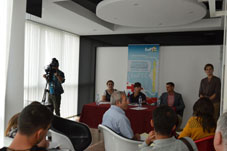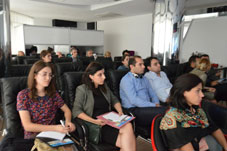
European Union Fosters cross-border regional development in EaP Countries
By Maia Edilashvili
Friday, October 23
After the EU-funded Territorial Cooperation Programme announced cross-border projects among the Armenian and Georgian applicants, the ball is now in the court of the non-government and governmental organizations from Azerbaijan and Georgia to draft attractive project proposals. The new round of Call for Proposals targets two Azeri and two Georgian regions located along the 480 km-long state border between Azerbaijan and Georgia and aims to strengthen bilateral cooperation. “What makes this programme very special is that it will be financed by the EU but without any involvement of the EU member countries,” says Stefan Elsing, representing the Managing Authority of the Programme, The Deutsche Gesellschaftfur Internationale Zusammenarbeit GmbH (GIZ ) – selected by the European Commission for this purpose.
The Azerbaijan-Georgia Territorial Cooperation Programme is one of the four programmes launched under the Eastern Partnership Territorial Cooperation (EaPTC), which aims to create favourable conditions for cross-border partnerships along the borders of Moldova-Ukraine, Armenia-Georgia, Azerbaijan-Georgia and Belarus-Ukraine, taking into account the specifics of each border area. The overall contribution by the EU to EaPTC is 12.5 million EUR.
Those seeking the EaPTC grant are required to find a partner in a bordering region from the partner country to jointly develop a project proposal. The Call for Proposals, which was announced on September 18, covers the Kakheti and Kvemo Kartli regions in Georgia as well as Ganja-Qazakh and Sheki-Zagatala in Azerbaijan.
The very first EaPTC winners
The Territorial Cooperation Programme Armenia-Georgia has been the first of all the four EaPTC programmes that already identified the winning projects and announced them on September 25.
The Civil Development Agency (CiDA), a Georgian civil society organization, which has been advocating the social and economic rights of Georgian citizens since 2002, is among the winners. As one of the main beneficiaries of the CiDA rural population, the organization had established contacts in Armenia, and so found a partner without difficulty: the Support for Noyemberyan NGO and Eurasia Partnership Foundation of Armenia.
“One of the major achievements of our project will be to produce a business catalogue where one will find the profiles of businesses operating in Kvemo-Kartli(Georgia) and the Tavush region (Armenia) as well as contact information so that it can serve as a guide for interested local entrepreneurs,” said Nino Chitorelidze, project manager at CiDA, whose project on cross-border economic cooperation received 211.397 EUR from the EU in the framework of EaPTC.
CiDA’s project will aim to connect businesses evolved in the agriculture sector in Georgia’s Kvemo Kartli and Armenia’s Tavush regions. As part of the project, which will run for 16 months, two agricultural trips will be organized to familiarize local entrepreneurs with the business environment in the neighbouring country’s adjacent region.
The ultimate idea, according to Chitorelidze, is to inform Armenian businesses about business perspectives in Georgia after the EU-Georgia Association Agreement, as well as about the opportunities for the Georgian market since Armenia joined the Eurasian Economic Union.
Plans and expectations
Azerbaijan and Armenia are Georgia’s top export destinations with the export to Azerbaijan standing at USD 544.5 million and to Armenia at USD 288 million in 2014, according to the state statistics office of Georgia. These figures illustrate how important the maintenance and deepening both economic and cultural links with them.
“We want to teach kids in the Bolnisi region (Georgia) Armenian fairy tales to inspire them to contemplate what kind of characters they have. In Gyumri (Armenia’s second largest city and the capital of the Shirak province), a similar process will take place and Georgian fairy tales will be taught to Armenian children,” said Irma Zurabishvili of Bolnisi Language House, from another winning project led by the Georgian partner. According to her, as part of the project, the children will draw fairy tale characters based on their imagination and afterwards these paintings will be used to create animated videos. The children will then discuss the videos and additionally, two camps will be created wherein theatrical shows will be staged based on what the children have learned.
The eligible entities to apply for the grants were the regional and local state authorities, communities and civil society organisations from the Kvemo-Kartli and Samtskhe?Javakheti regions of Georgia as well as from Lori, Shirak and Tavush marzes of Armenia. While these Armenian regions are primarily monoethnic, the picture in Georgia is different. More than half of Samtskhe-Javakheti population is ethnic Armenian and approximately 45 % of Kvemo-Kartli’s population is ethnic Azeri, which creates both the need and the opportunity for cultural exchanges.
This is exactly why Zurabishvili of the Bolnisi Language House thinks that her project, developed in partnership with the Armenian partner, Ashot Mirzoyan of City Research Center, will succeed. “Our project has a sensitive touch – fairy tales are important to cultures, and it’s amazing how much fairy tales can say about us,” Mirzoyan said. This project received 54,135 EUR funding from the EU.
The other two lead partners from Georgia are the Society Development Center of Akhaltsikhe with the project “Sustainable Forest and Energy Solutions through Cross Border Cooperation” and the Society of Democratic Women of Marneuli with the project “Youth Voices for Change and Development.” The awarded four lead partners from Armenia are: Ijevan Municipality, NGO Center Civil Society Development Organisation, Youth Cooperation Center of Dilijan NGO, and Meghvik NGO. In total, 40 project proposals were competing for the Armenia-Georgia grant contracts, for which the EU allocated 1.35 million EUR.
Giorgi Tsakadze, the Head of the Department for Self-governance and Regional Policy at the Ministry of Infrastructure and Regional Development of Georgia, believes that the winning projects will help increase trust on both sides of the border. “The main success will be the improvement in cultural and people-to-people relations, as a programme of this scale could not provide a major economic impact,” he said. Tsakadze was also optimistic about the projects focused on ecology, stating that “a significant change can be made through minor spending”.
“Musts” and opportunities
Requested funding for EaPTC projects should be in the range of 20,000 and 250, 000 EUR and focus on priority areas set as a result of a year-long study of the cross-border regions, involving consultations with local communities and representatives of state and non-state organizations.
For example, the priority for Azerbaijan-Georgia cross-border projects is partnerships in agriculture, tourism and related sectors that focus on solving common environmental problems and strengthen emergency responses, as well as to facilitate social inclusion in the areas of culture, education and sports and develop links between young people. The total budget is 1.35 million EUR and interested organizations will be able to submit their project proposals until December 17.
Once the winners have been revealed, contracts are then signed, giving a green light to the project implementation phase. The maximum project duration is 18 months and throughout this time grantees will be constantly monitored. According to Alexei Sekarev, Team Leader at EaPTC Support Programme, applying for the project implies that there is a very clear timeline which objectives and results will be achieved. “This allows us to monitor the project implementation very closely,” he said.


